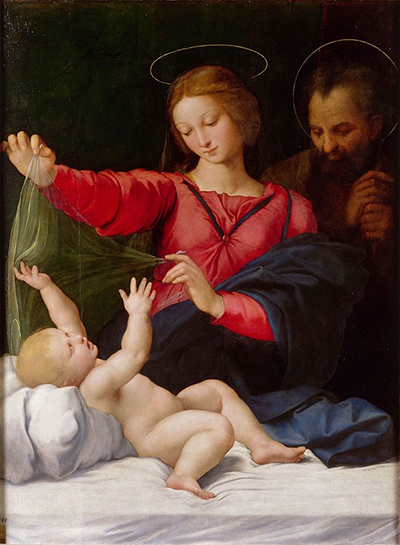The Madonna of Loreto was created between 1508 and 1509 by Raphael, the famous Italian High Renaissance painter.
For hundreds of years afterwards this remarkable work of art kept company with another Raphael painting: Portrait of Pope Julius II, initially a the Santa Maria del Popolo, and afterwards in private collections. Then they disappeared from the public domain for a quite a while. The history of this particular Raphael painting is hard to track for a variety of reasons, e.g. the many names used for the artwork. Madonna of Loreto is also one of Raphael's most reproduced paintings, with more than a hundred known copies out there.
During the period at Santa Maria del Popolo it went under the name of the Madonna del Popolo, while it was also often described as the Holy Family. It is sometimes also called Madonna of the Veil or Madonna del Velo, although not consistently. And to complicate the issue even further, those names have also been used for another painting, the Madonna with the Blue Diadem. It does, however, most frequently go under the name of Madonna of Loreto.
One thing about which there is no doubt is that this painting is intimate and tender. The Child, who just woke up, plays a simple game with the Madonna's veil, while a rather sad looking Saint Joseph watches from the shadows. Renaissance paintings, from the time of the Meditations on the Life of Christ, use the veil to symbolize the way in which the Madonna gently wrapped the Child in her veil, starting at the Nativity and later, rather prophetically, during the Crucifixion.
Saint Joseph's quite somber appearance in this painting might hint at the fact that he was deeply aware of what the prophecies predicted for the future of the Child. Saint Joseph also appears to have been introduced as an after-thought. X-rays of the painting revealed that his image wasn't originally there: it replaced a window that used to be visible over the shoulder of the Madonna. Apart from that x-rays also revealed that the position of the child's foot was changed afterwards, a finding that confirms Raphael's original drawings for the painting. The Madonna's frame, angle of her head and also her dress reminds the viewer of Justice in the Stanza della Segnatura, an artwork that was painted at more or less the same time. It is also quite similar to the Madonna of the Blue Diadem.
The painting that is presently residing in the French city of Chantilly is widely believed to be the original, although its whereabouts during the time of the French revolution between 1789 and 1799 remains a mystery. The Musée Condé in October 1979 arranged an exhibition called La Madonna de Loreto at which it presented and documented a freshly cleaned version of the artwork, and this has since been established to be the original Raphael painting.




